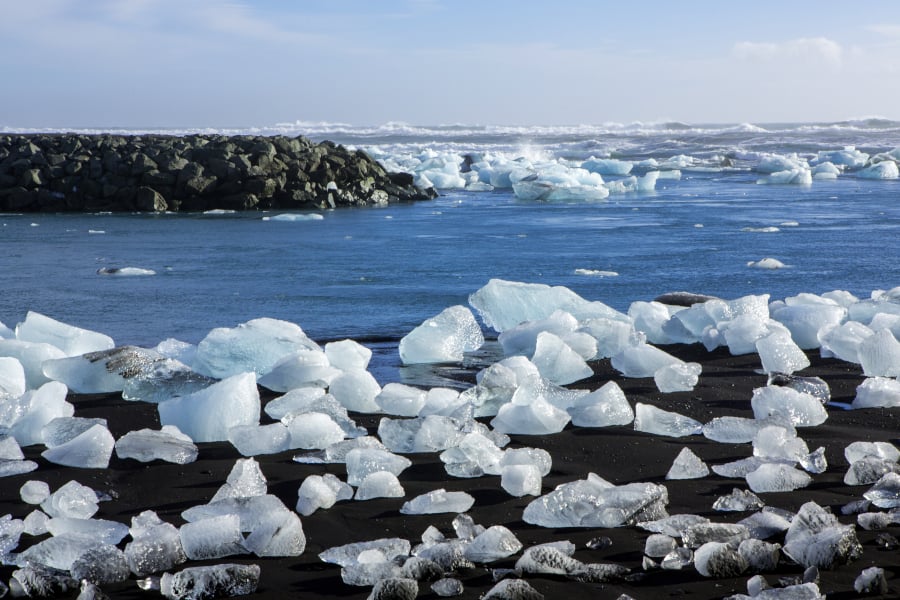Is ice a mineral? Is it a rock? Maybe it’s both, or neither! The status of ice as a mineral or rock is a question that comes up pretty frequently. This post will thoroughly answer the question and put any debate to rest.
Ice is definitely a mineral. It meets all four of the requirements set forth in the definition of a mineral: It is naturally occurring, solid, has an organized crystal structure, and has a well-defined chemical composition. Ice is also technically a rock. Water, however, is not a mineral.
While the answer may seem cut and dry, there are some subtle distinctions that require a bit more explanation. There are some exceptions and interesting quirks if you dig a little bit deeper into this question.

Is Ice a Mineral?
Ice is a mineral… usually. The big exception is when it is man-made. This goes back to the definition of a mineral. The International Mineralogical Association defines a mineral as a substance that meets the following criteria:
- It is a naturally occurring substance formed by natural geological processes
- It is a solid substance in its natural occurrence
- It has a well-defined crystallographic structure
- It has a well-defined chemical composition
As it occurs in nature, ice meets all of these requirements. If water gets below freezing it will naturally form ice, which is, of course, a solid. The ice crystals are well organized into a crystal lattice, and its chemical composition is simply H2O.
It is worth noting that many definitions of a mineral include the stipulation that it be inorganic. However, in this instance it really doesn’t matter since water isn’t produced by living organisms.
So the exception to ice being a mineral is when it is man-made. It no longer satisfies the first requirement of being formed naturally by geological processes.
In my opinion this distinction is purely semantic. Ice obviously can (and usually does) form in nature. Just because a person makes it in their freezer doesn’t make the ice any less of a crystal. But if you really want to get technical then man-made ice is not considered to be a mineral.
It is interesting to think about ice in terms of it being a mineral. It means that the smallest snowflake to the largest glacier are both minerals. While vastly different in size and shape, they both meet the definition of a mineral.
There are some mineralogists who have proposed that in order to qualify as a mineral a substance needs to be solid at room temperature. This opinion is pretty fringe, however, and is really only considered in specific applications that would not pertain to ice.
If you need any more convincing that ice is, in fact, a mineral, I would point you to the IMA official list of all minerals. In it you will find ice listed among the thousands of other officially recognized minerals in the world.
Is Water a Mineraloid?
Another interesting aspect of this discussion is how water is classified. There are some people who argue that water should be considered a mineraloid. A mineraloid is any substance which meets most of the requirements of a mineral but falls short in some way or another.
According to the definition we laid out above, water meets three out of the four requirements so it is very reasonable to claim it is a mineraloid. The only thing holding back from mineral status is that it isn’t a solid.
Personally, I do not consider water to be a mineraloid. This classification of substances is usually reserved for solids that tend to exhibit too much chemical variation or lack crystallinity.
Is Ice a Rock?
This question is a little tricker than asking if ice is a mineral. When people think of rocks they don’t usually picture ice, but by just about any criteria ice can be called a rock. Let’s take a look at the definition of a rock:
A rock is any naturally occurring solid mass or aggregate of minerals or mineraloid matter.
By this definition, a sufficient amount ice can usually be considered to be a rock. A snowflake would not be considered a rock because it isn’t a large enough mass or collection of mineral crystals.
Once there is a mass of snow or ice packed together then it is technically considered to be a rock. So whenever you’re throwing a perfect snowball at your friends, you’re actually pelting them with a rock! The snow has to be well packed together in order to be considered a rock, otherwise it would not meet the ‘solid mass’ criteria.
What Kind of Rock Is Ice?
Now we’re really getting into some interesting territory. Depending on how the ice was formed and what has happened to it since, ice may be classified as sedimentary or metamorphic. Clearly ice could never be considered igneous since it doesn’t form from the solidification of magma or lava flows.
Most of the ice on the planet is contained in glaciers and would be considered metamorphic rock. Due to the overlying pressure from the years of accumulated snow above them, millions of individual snowflakes (ice crystals) are reorganized into larger ice crystals.

Any rock that forms due to the effects of pressure and/or heat on another rock is considered to be metamorphic. A glacier, for example, would be classified as one giant rock! According to the USGS, it would be defined as a mono-mineralic rock (a rock made up of only one type of mineral.)
But wait… if ice is a metamorphic rock, and a metamorphic rock is formed from pre-existing rock, what was the ice beforehand? Well, the answer is that snow can actually be considered a sedimentary rock! This snow is would be called the ‘protolith’ of glacial ice – it’s what the glacial ice was born from.
Sedimentary rocks are usually broken down into three basic categories – clastic, chemical, and biochemical. Snow would be placed in the ‘chemical’ category.
Snow forms when the cold air becomes over-saturated with water, causing the snowflakes to precipitate out of the air. This process qualifies as chemical sedimentation, which is one of the four ways sedimentary rocks form.
So, snow falls to the ground and becomes firn. Firn is sort of a halfway point between snow and glacial ice. It is formed when snowflakes undergo pressure solution – basically when they fall to the ground and get mashed together in a snow bank.
Firn is a sort of granular ice and found on top of glaciers. It can be considered a chemical sedimentary rock, but once it is subjected to more and more pressure from the snow above it will transform into glacial ice.
This metamorphization happens because the edges of the snowflakes and smaller ice crystals partially melt at their edges. When they have enough pressure being applied from the snow above, they partially melt and then fuse together to form larger crystals. They eventually become one solid mass of ice – a rock!
Does That Mean Water is Lava?
This notion seems silly on the surface, but is actually a legitimate question. If ice is a rock, and lava is melted rock, then wouldn’t water be classified as lava?
Well, no. The actual definition of lava is:
Hot molten or semifluid rock erupted from a volcano or fissure, or solid rock resulting from cooling of this.
Obviously, melted ice is not erupted from a volcano, so it does not meet this definition. That doesn’t mean that you can’t melt your friends’ brains by posing this question to them, though!
